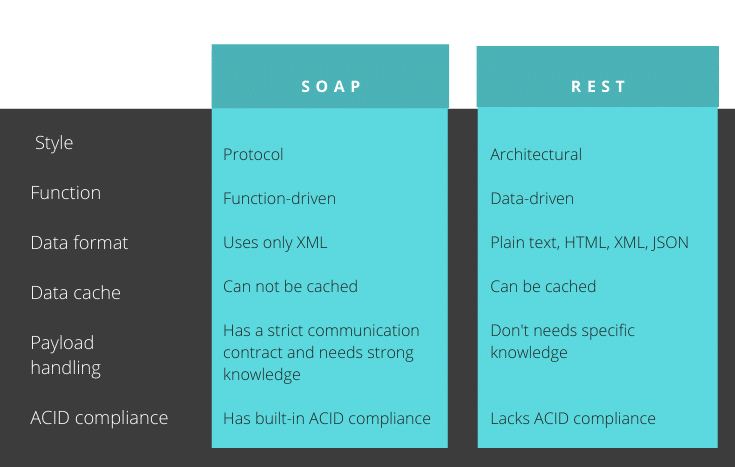API vs. Web Services. The Main Differences and Types of Web Services
There is much common ground between web services and API (Application Programming Interface). The distinctions, however, are often overlooked, and the two are mistaken for each other and sometimes used interchangeably. API and web services are not mutually exclusive, but the two are essentially different concepts.
API is a list of commands that act as a messenger between data points that carries information from one place to another. For example, Twitter utilizes API, which authorizes a developer to access a server to retrieve tweets, which are then collected in JSON format.
Web Services are client and server-based software applications designed to support interoperability for machine-to-machine interactions over a network. Essentially they serve as a method by which an HTTP request is sent to a URL with particular arguments with the web service responding.
One important thing to bear in mind is that all web services are APIs, but the reverse is not always true. This can be confusing for many, so let’s try to clarify the differences between web services and API.
Similarities
Both APIs and web services allow communication between providers and customers that is enabled by both being accessed through HTTP/HTTPS. Both act as message carriers. They call a function, interpret the provided data, and then return a response based on the particular data provided.Before the advancements to web services, communication and integration between two data points were limited and quite burdensome. Differing data formats, vendors, technologies, and B2B operations struggled to streamline effective data exchange. Web services now (often with the inclusion of API) offer a less complex, integrated, and effectively functional solution to this type of communication.
Differences
One key difference between API and web services is where they can be hosted. While a web service can be hosted only on IIS (Internet Information Services), APIs can be on IIS or hosted within an application. Another difference is that web services are not open source and are confined to using only XML and, therefore, can only be used by clients who understand it. On the other hand, APIs are open source and can be used by clients who understand various formats, including XML and JSON.
The architecture of API is light, but since web services need a Simple Object Access Protocol (SOAP) to receive data over a network, the architecture is more weighted. Web services are limited to a need to leverage SOAP, REST, and XML-RPC forms of communication, while the APIs are not confined in such a manner, being able to use any form of communication.
Additionally, while API is capable of supporting URLs, caching, content formats, request/response headers, and content formats, web services can only support HTTP communication.
Discover the difference between web services and API:

Types of web services
There are two primary types of web services: SOAP and REST.
Soap
SOAP (Simple Object Access Protocol) is used to facilitate the exchange of data between different applications, a crucial component in an interconnected world network. Every programming language can understand XML, so theoretically, it can be used to reduce the complexity presented by trying to talk to different applications.
Because of a great deal of variety between different applications and their makeup, using XML as the common ground makes a lot of sense. The problem is that there is no one set of rules to govern how to use XML to communicate between them. SOAP is the set of guidelines that standardize how XML can be used across these different apps to some extent. SOAP contains a more standardized set of abbreviations, acronyms, messaging, security, policy, coordination, transaction, and many other aspects linking various applications. Each particular task will require a different set of pieces needed for communication, and SOAP is available to pluck the necessary pieces and put them together to manage the messaging.
REST
REST (Representational State Transfer) is a defined set of principles that a client would need to use to extract and return the resources it needs for its particular purpose or task. Much like SOAP, it allows for communication between different programming languages, which comprise applications located on various machines running their own particular brand of operating systems. Because one side of communication (the client) is reaching out to another (the server), it is incumbent upon the client to ensure that the proper parameters, attributes, and specifications are provided. These then leverage REST protocols to retrieve information from the server to return the specific information needed to the client.
SOAP vs. RESTful Services
So which is better? That is a question that has posed a lot of debate between developers, and there is no really one clear winner who holds the advantage. This is mostly because SOAP and REST are more or less useful in specific types of situations and scenarios, and leveraging one instead of the other is more of a situational convenience.
While REST requires HTTP for its communication, SOAP is largely free of dependence on a particular language, transport method, and platform. REST is better for communication between two points, whereas SOAP is more standardized and works better for grander distributed enterprise environments. SOAP also has a significant amount of pre-built extensibility in the form of their WS* standards and, when used with certain languages, has more inherent automation. On top of that, SOAP has built-in error handling.
REST is a simpler approach with less extensive tools and a much smaller learning curve. This simplicity also makes it more efficient as it utilizes smaller message formats when needed, unlike SOAP which leverages XML for all of its communication means. This also makes REST faster as the processing time required is much lower for simpler, smaller transactions. The speed is also helped by REST caching static information (information that is generally not altered or dynamic).

Whether SOAP or REST is going to be used depends largely on the users’ requirements. Sometimes, the answer to which is more useful is both. Amazon and eBay are two examples of major online markets that utilize both service types. That is largely due to the vastness of their interaction with applications. Some make more sense to integrate the use of one versus the other, but as a business grows and diversifies its interactions, it becomes more pertinent to explore the use of both, situationally dependent, to achieve maximum efficacy and versatility for inter-app communication.
What is the most widely used API for web services?
When it comes to web services, one API stands tall above the rest, and it’s none other than the reliable REST API. With an astounding 93.4% adoption rate among API developers, REST continues to be the top choice in the industry. And it’s no surprise why. The REST API is versatile and widely used due to its ability to facilitate communication between web applications effortlessly. Not only does it simplify the process, but it also ensures secure synchronization and data exchange between applications.
One of the key factors behind REST’s unmatched popularity is its utilization of standard HTTP methods such as GET, POST, PUT, and DELETE. This uniform approach simplifies implementation and garners widespread support throughout the web.









